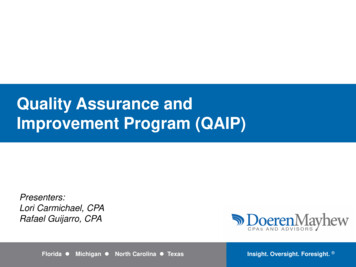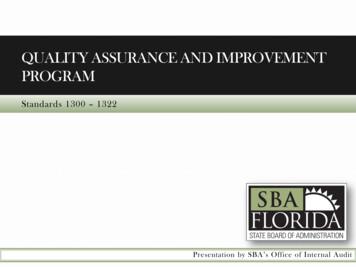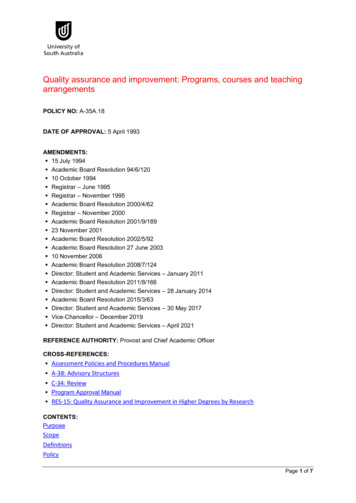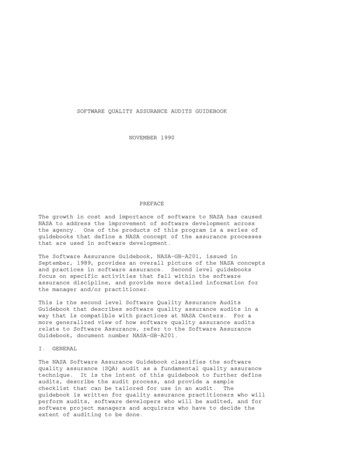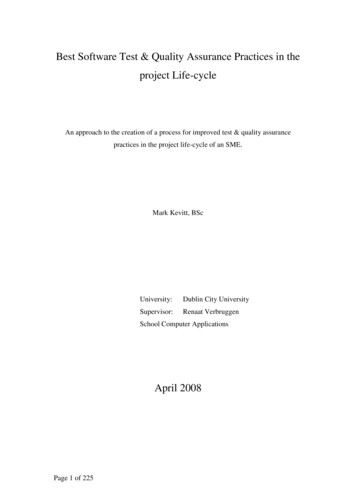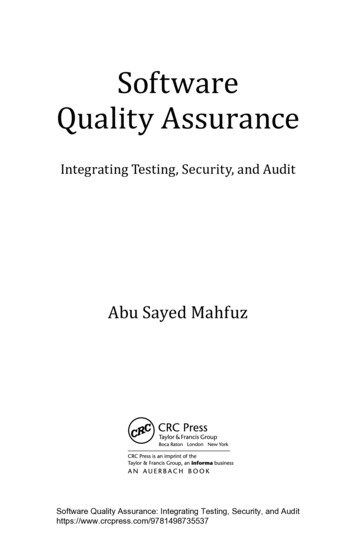
Transcription
DOE-EH-4.2.1.3-EPIcode-Gap AnalysisDefense Nuclear Facilities Safety Board Recommendation 2002-1Software Quality Assurance Improvement PlanCommitment 4.2.1.3:Software Quality Assurance Improvement Plan:EPIcode Gap AnalysisFinal ReportU.S. Department of EnergyOffice of Environment, Safety and Health1000 Independence Ave., S.W.Washington, DC 20585-2040May 2004
EPICODE Gap AnalysisFinal ReportMay 2004INTENTIONALLY BLANKii
EPICODE Gap AnalysisFinal ReportMay 2004FOREWORDThis report documents the outcome of an evaluation of the Software Quality Assurance (SQA) attributes ofthe chemical source term and atmospheric dispersion computer code, EPIcode, relative to establishedrequirements. This evaluation, a “gap analysis”, is performed to meet commitment 4.2.1.3 of theDepartment of Energy’s Implementation Plan to resolve SQA issues identified in the Defense NuclearFacilities Safety Board Recommendation 2002-1.Suggestions for corrections or improvements to this document should be addressed to –Chip LagdonEH-31/GTNU.S. Department of EnergyWashington, D.C. 20585-2040Phone (301) 903-4218Email: chip.lagdon@eh.doe.goviii
EPICODE Gap AnalysisFinal ReportMay 2004INTENTIONALLY BLANKiv
EPICODE Gap AnalysisFinal ReportMay 2004REVISION STATUSPage/SectionRevisionChange1. Entire Document1. Interim Report1. Original Issue2. Entire Document2. Final Report, May 3, 20042. Updated all sections per reviewcomments.v
EPICODE Gap AnalysisFinal ReportMay 2004INTENTIONALLY BLANKvi
EPICODE Gap AnalysisFinal ReportMay 2004CONTENTSSectionPageFOREWORDIIIREVISION STATUSVEXECUTIVE IIIBACKGROUND: OVERVIEW OF DESIGNATED TOOLBOX SOFTWARE IN THECONTEXT OF 10 CFR 830EVALUATION OF TOOLBOX CODESUSES OF THE GAP ANALYSISSCOPEPURPOSEMETHODOLOGY FOR GAP ANALYSISSUMMARY DESCRIPTION OF SOFTWARE BEING REVIEWED1-11-21-21-21-31-31-5ASSESSMENT SUMMARY RESULTS2-12.12.22.32.42-12-12-22-2CRITERIA METEXCEPTIONS TO REQUIREMENTSAREAS NEEDING IMPROVEMENTCONCLUSION REGARDING CODES ABILITY TO MEET INTENDED FUNCTION3.0LESSONS LEARNED3-34.0DETAILED RESULTS OF THE ASSESSMENT PROCESS4-34.14.24.34.44.5TOPICAL AREA 1 ASSESSMENT: SOFTWARE CLASSIFICATION4.1.1 Criterion Specification and Result4.1.2 Sources and Method of Review4.1.3 Software Quality-Related Issues or Concerns4.1.4 RecommendationsTOPICAL AREA 2 ASSESSMENT: SQA PROCEDURES AND PLANS4.2.1 Criterion Specification and Result4.2.2 Sources and Method of Review4.2.3 Software Quality-Related Issues or Concerns4.2.4 RecommendationsTOPICAL AREA 3 ASSESSMENT: REQUIREMENTS PHASE4.3.1 Criterion Specification and Result4.3.2 Sources and Method of Review4.3.3 Software Quality-Related Issues or Concerns4.3.4 RecommendationsTOPICAL AREA 4 ASSESSMENT: DESIGN PHASE4.4.1 Criterion Specification and Result4.4.2 Sources and Method of Review4.4.3 Software Quality-Related Issues or Concerns4.4.4 RecommendationsTOPICAL AREA 5 ASSESSMENT: IMPLEMENTATION 4-84-94-94-114-114-114-12
EPICODE Gap AnalysisFinal Report4.64.74.84.94.104.114.12May 20044.5.1 Criterion Specification and Result4.5.2 Sources and Method of Review4.5.3 Software Quality-Related Issues or Concerns4.5.4 RecommendationsTOPICAL AREA 6 ASSESSMENT: TESTING PHASE4.6.1 Criterion Specification and Result4.6.2 Sources and Method of Review4.6.3 Software Quality-Related Issues or Concerns4.6.4 RecommendationsTOPICAL AREA 7 ASSESSMENT: USER INSTRUCTIONS4.7.1 Criterion Specification and Result4.7.2 Sources and Method of Review4.7.3 Software Quality-Related Issues or Concerns4.7.4 RecommendationsTOPICAL AREA 8 ASSESSMENT: ACCEPTANCE TEST4.8.1 Criterion Specification and Result4.8.2 Sources and Method of Review4.8.3 Software Quality-Related Issues or Concerns4.8.4 RecommendationsTOPICAL AREA 9 ASSESSMENT: CONFIGURATION CONTROL4.9.1 Criterion Specification and Result4.9.2 Sources and Method of Review4.9.3 Software Quality-Related Issues or Concerns4.9.4 RecommendationsTOPICAL AREA 10 ASSESSMENT: ERROR IMPACT4.10.1 Criterion Specification and Result4.10.2 Sources and Method of Review4.10.3 Software Quality-Related Issues or Concerns4.10.4 RecommendationsTRAINING PROGRAM ASSESSMENTSOFTWARE -16.0ACRONYMS AND DEFINITIONS6-17.0REFERENCES7-1APPENDIX A. — SOFTWARE INFORMATION TEMPLATEviiiA-1
EPICODE Gap AnalysisFinal ReportMay 2004TABLESPageTable 1-1 — Plan for SQA Evaluation of Existing Safety Analysis Software1-3Table 1-2 — Summary Description of EPIcode Software1-6Table 1-3 — Software Documentation Reviewed for EPIcode1-9Table 2-1 — Summary of Important Exceptions, Reasoning, and Suggested Remediation2-1Table 2-2 — Summary of Important Recommendations for EPIcode2-2Table 4-0-1— Cross-Reference of Requirements with Subsection and Entry from DOE (2003e)4-3Table 4.1-1 — Subset of Criteria for Software Classification Topic and Results4-4Table 4.2-1 — Subset of Criteria for SQA Procedures and Plans Topic and Results4-6Table 4.3-1 — Subset of Criteria for Requirements Phase Topic and Results4-7Table 4.4-1 — Subset of Criteria for Design Phase Topic and Results4-9Table 4.5-1 — Subset of Criteria for Implementation Phase Topic and Results4-12Table 4.6-1 — Subset of Criteria for Testing Phase Topic and Results4-13Table 4.7-1 — Subset of Criteria for User Instructions Topic and Results4-16Table 4.8-1 — Subset of Criteria for Acceptance Test Topic and Results4-18Table 4.9-1 — Subset of Criteria for Configuration Control Topic and Results4-19Table 4.10-1 — Subset of Criteria for Error Impact Topic and Results4-20ix
EPICODE Gap AnalysisFinal ReportMay 2004INTENTIONALLY BLANKx
EPICODE Gap AnalysisFinal ReportMay 2004FIGURESNonexi
EPICODE Gap AnalysisFinal ReportMay 2004INTENTIONALLY BLANKxii
EPICODE Gap AnalysisFinal ReportMay 2004Software Quality Assurance Improvement Plan:EPIcode Gap AnalysisEXECUTIVE SUMMARYThe Defense Nuclear Facilities Safety Board (DNFSB) issued Recommendation 2002-1 on QualityAssurance for Safety-Related Software in September 2002 (DNFSB 2002). The Recommendationidentified a number of quality assurance issues for software used in the Department of Energy (DOE)facilities for analyzing hazards, and designing and operating controls that prevent or mitigate potentialaccidents. The development and maintenance of a collection, or “toolbox,” of high-use, Software QualityAssurance (SQA)-compliant safety analysis codes is one of the major improvement actions discussed inthe Implementation Plan for Recommendation 2002-1 on Quality Assurance for Safety Software atDepartment of Energy Nuclear Facilities. A DOE safety analysis toolbox would contain a set ofappropriately quality-assured, configuration-controlled, safety analysis codes, managed and maintained forDOE-broad safety basis applications.The EPIcode 7.0 software for chemical source term and atmospheric dispersion and consequence analysis,is one of the codes designated for the toolbox. To determine the actions needed to bring the EPIcode 7.0software into compliance with the SQA qualification criteria, and develop an estimate of the resourcesrequired to perform the upgrade, the Implementation Plan has committed to sponsoring a code-specific gapanalysis document. The gap analysis evaluates the software quality assurance attributes of EPIcode 7.0against identified criteria.The balance of this document provides the outcome of the EPIcode gap analysis compliant with NQA-1based requirements. Of the ten SQA requirements for existing software at the Level B classification(important for safety analysis but whose output is not applied without further review), two requirementsare met at acceptable level, i.e., Classification (1) and User Instructions (7). Improvement actions arerecommended for EPIcode to fully meet the remaining eight requirements. This evaluation outcome isdeemed acceptable because: (1) EPIcode is used as a tool, and as such its output is applied in safetyanalysis only after appropriate technical review; (2) User-specified inputs are chosen at a reasonablyconservative level of confidence; and (3) Use of EPIcode is limited to those analytic applications for whichthe software is intended.Suggested remedial actions for this software would warrant upgrading software documents. The completelist of revised baseline documents includes: Software Quality Assurance PlanSoftware Requirements DocumentSoftware Design DocumentTest Case Description and ReportSoftware Configuration and ControlError Notification and Corrective Action Report, andUser’s Manual.xiii
EPICODE Gap AnalysisFinal ReportMay 2004It is estimated that a concentrated program to upgrade the SQA pedigree of EPIcode to be compliant withthe ten criteria discussed here would require fourteen to sixteen full-time equivalent (FTE)-months.It was determined that the EPIcode 7.0 does meet its intended function for use in supporting documentedsafety analysis. However, as with all safety-related software, users should be aware of current limitationsand capabilities of the software for supporting safety analysis. Informed use of the code can be assisted byappropriate use of current EPIcode documentation and the EPIcode guidance report for DOE safetyanalysts, EPIcode Computer Code Application Guidance for Documented Safety Analysis, (DOE, 2004).Furthermore, while SQA improvement actions are recommended for EPIcode, no evidence has been foundof programming, logic, or other types of software errors in EPIcode 7.0 that have led to non-conservatismsin nuclear facility operations, or in the identification of facility controls.xiv
EPICODE Gap AnalysisFinal ReportMay 2004INTENTIONALLY BLANKxv
EPICODE Gap AnalysisFinal Report1.0May 2004IntroductionThis document reports on the results of a gap analysis for Version 7.0 of the EPIcode computer code. Theintent of the gap analysis is to determine the actions needed to bring the designated software intocompliance with established Software Quality Assurance (SQA) criteria. A secondary aspect of thisreport is to develop an estimate of the level of effort required to upgrade each code based on the gapanalysis results.1.1Background: Overview of Designated Toolbox Software in the Context of 10 CFR 830In January 2000, the Defense Nuclear Facilities Safety Board (DNFSB) issued Technical Report 25,(TECH-25), Quality Assurance for Safety-Related Software at Department of Energy Defense NuclearFacilities (DNFSB, 2000). TECH-25 identified issues regarding computer software quality assurance(SQA) in the Department of Energy (DOE) Complex for software used to make safety-related decisions,or software that controls safety-related systems. Instances were noted of computer codes that were eitherinappropriately applied, or were executed with incorrect input data. Of particular concern wereinconsistencies in the exercise of SQA from site to site, and from facility to facility, and the variability inguidance and training in the appropriate use of accident analysis software.While progress was made in resolving several of the issues raised in TECH-25, the DNFSB issuedRecommendation 2002-1 on Quality Assurance for Safety-Related Software in September 2002. TheDNFSB enumerated many of the points noted earlier in TECH-25, but noted specific concerns regardingthe quality of the software used to analyze and guide safety-related decisions, the quality of the softwareused to design or develop safety-related controls, and the proficiency of personnel using the software.The Recommendation identified a number of quality assurance issues for software used in the DOEfacilities for analyzing hazards, and designing and operating controls that prevent or mitigate potentialaccidents. The development and maintenance of a collection, or “toolbox,” of high-use, SQA-compliantsafety analysis codes is one of the major commitments contained in the February 28, 2003Implementation Plan for Recommendation 2002-1 on Quality Assurance for Safety Software atDepartment of Energy Nuclear Facilities (IP). In time, the DOE safety analysis toolbox will contain a setof appropriately quality-assured, configuration-controlled, safety analysis codes, managed and maintainedfor DOE-broad safety basis applications.Six computer codes, including ALOHA (chemical release dispersion/consequence analysis), CFAST (fireanalysis), EPIcode (chemical release dispersion/consequence analysis), GENII (radiologicaldispersion/consequence analysis), MACCS2 (radiological dispersion/consequence analysis), andMELCOR (leak path factor analysis), were designated by DOE for the toolbox (DOE/EH, 2003). It isfound that this software provides generally recognized and acceptable approaches for modeling sourceterm and consequence phenomenology, and can be applied as appropriate to support accident analysis inDocumented Safety Analyses (DSAs).As one of the designated toolbox codes, EPIcode Version 7.0 is likely to require some degree of qualityassurance improvement before meeting current SQA standards. The analysis of this document evaluatesEPIcode Version 7.0 relative to current software quality assurance criteria. It assesses the extent of thedeficiencies, or gaps, to provide DOE and the software developer the extent to which minimum upgradesare needed. The overall assessment is therefore termed a “gap” analysis.1-1
EPICODE Gap AnalysisFinal Report1.2May 2004Evaluation of Toolbox CodesThe quality assurance criteria identified in later sections of this report are defined as the set of establishedrequirements, or basis, by which to evaluate each designated toolbox code. This evaluation process, a gapanalysis, is commitment 4.2.1.3 in the IP:Perform a SQA evaluation to the toolbox codes to determine the actions needed to bringthe codes into compliance with the SQA qualification criteria, and develop a schedulewith milestones to upgrade each code based on the SQA evaluation results.This process is a prerequisite step for software improvement. It will allow DOE to determine the currentlimitations and vulnerabilities of each code as well as help define and prioritize the steps required forimprovement.Ideally, each toolbox code owner will provide complete information on the SQA programs, processes,and procedures used to develop their software. However, the gap analysis itself will be performed by aSQA evaluator. The SQA evaluator is independent of the code developer, but knowledgeable in the useof the software for accident analysis applications and current software development standards.1.3Uses of the Gap AnalysisThe gap analysis provides key information to DOE, code developers, and code users.DOE obtains the following benefits: Estimate of the resources required to perform modifications to designated toolbox codes Basis for schedule and prioritization to upgrade each designated toolbox code.Each code developer is provided: Information on areas where software quality assurance improvements are needed to comply withindustry SQA standards and practices Specific areas for improvement to guide development of new versions of the software.DOE safety analysts and code users benefit from: Improved awareness of the strengths, limits, and vulnerable areas of each computer code Recommendations for code use in safety analysis application areas.1.4ScopeThis analysis is applicable to the EPIcode, one of the six designated toolbox codes for safety analysis.While EPIcode is the subject of the current report, other safety analysis software considered for thetoolbox in the future may be evaluated with the same process applied here. The template outlined here isapplicable for any analytical software as long as the primary criteria are ASME NQA-1, 10 CFR 830, andrelated DOE directives discussed in DOE (2003e).1-2
EPICODE Gap AnalysisFinal Report1.5May 2004PurposeThe purpose of this report is to document the gap analysis performed on the EPIcode as part of DOE’simplementation plan on SQA improvements.1.6Methodology for Gap AnalysisThe gap analysis for EPIcode is based on the plan and criteria described in Software Quality AssurancePlan and Criteria for the Safety Analysis Toolbox Codes (DOE 2003e). The overall methodology for thegap analysis is summarized in Table 1-1. The gap analysis reported here utilizes ten of the fourteentopical areas listed in DOE (2003e) related to software quality assurance to assess the quality of theEPIcode 7.0 computer code. The ten areas are those particularly applicable to the software development,specifically: (1) Software Classification, (2) SQA Procedures/Plans, (5) Requirements Phase, (6) DesignPhase, (7) Implementation Phase, (8) Testing Phase, (9) User Instructions, (10) Acceptance Test, (12)Configuration Control, and (13) Error Impact. Each area, or requirement, is assessed individually inSection 4. Each area or requirement is assessed individually in Section 4.Requirements 3 (Dedication), 4 (Evaluation), and 14 (Access Control), are not applicable for the softwaredevelopment process, and thus are not evaluated in this review. Requirement 4 (Evaluation) is an outlineof the minimum steps to be undertaken in a software review, and is complied with by evaluating the areaslisted above. Requirement 11 (Operation and Maintenance) is only partially applicable to softwaredevelopment, and is interpreted to be applicable mostly to the software user organization.An information template was transmitted to the Safety Analysis Software Developers on 20 October 2003to provide basic information as input to the gap analysis process (O’Kula, 2003). The core section of thetemplate is attached as Appendix A to the present report. It is noted that the written response provided bythe EPIcode software developer to the information template was incomplete.Table 1-1 — Plan for SQA Evaluation of Existing Safety Analysis Software1PhaseProcedure1. Prerequisitesa. Determine that sufficient information is provided by the software developer to allow it tobe properly classified for its intended end-use.b. Review SQAP per applicable requirements in Table 3-3.a. Review SQAP for: Required activities, documents, and deliverables Level and extent of reviews and approvals, including internal and independent review.Confirm that actions and deliverables (as specified in the SQAP) have been completedand are adequate.b. Review engineering documentation identified in the SQAP, e.g., Software Requirements Document Software Design Document Test Case Description and Report Software Configuration and Control Document Error Notification and Corrective Action Report, and User’s Instructions (alternatively, a User’s Manual), Model Description (if thisinformation has not already been covered).2. SoftwareEngineering ProcessRequirements1Originally documented as Table 2-2 in DOE (2003e).1-3
EPICODE Gap AnalysisFinal ReportPhaseMay 2004Procedurec. Identify documents that are acceptable from SQA perspective. Note inadequatedocuments as appropriate.1-4
EPICODE Gap AnalysisFinal ReportMay 2004Table 1-1 — Plan for SQA Evaluation of Existing Safety Analysis Software (continued)PhaseProcedure3. Software ProductTechnical/FunctionalRequirementsa. Review requirements documentation to determine if requirements support intended usein Safety Analysis. Document this determination in gap analysis document.b. Review previously conducted software testing to verify that it sufficiently demonstratedsoftware performance required by the Software Requirements Document. Document thisdetermination in the gap analysis document.4. Testinga. Determine whether past software testing for the software being evaluated providesadequate assurance that software product/technical requirements have been met. Obtaindocumentation of this determination. Document this determination in the gap analysisreport.b. (Optional) Recommend test plans/cases/acceptance criteria as needed per the SQAP iftesting not performed or incomplete.5. New SoftwareBaselinea. Recommend remedial actions for upgrading software documents that constitute baselinefor software. Recommendations can include complete revision or providing newdocumentation. A complete list of baseline documents includes: Software Quality Assurance Plan Software Requirements Document Software Design Document Test Case Description and Report Software Configuration and Control Error Notification and Corrective Action Report, and User’s Instructions (alternatively, a User’s Manual)b. Provide recommendation for central registry as to minimum set of SQA documents toconstitute new baseline per the SQAP.6. Traininga. Identify current training programs provided by developer.b. Determine applicability of training for DOE facility safety analysis.a. Identify planned improvements of software to comply with SQA requirements.b. Determine software modifications planned by developer.c. Provide recommendations from user community.d. Estimate resources required to upgrade software.7. SoftwareEngineeringPlanning1.7Summary Description of Software Being ReviewedThe gap analysis was performed on version 7.0 of the EPIcode (note: EPIcode is a registered trademarkof Homann Associates, Inc.). EPIcode was developed by Homann Associates, Inc., which maintains andupgrades the code. The code is commercially available from Homann Associates, Inc. The technicalcontact for EPIcode is the code author, Steven Homann (www.epicode.com, or epicode@aol.com).EPIcode performs calculations for source terms and downwind concentrations. Source term calculationsdetermine the rate at which the chemical material is released to the atmosphere, release height, releaseduration, and the form and properties of the chemical upon release. The analyst specifies the chemicaland then either specifies the chemical source term rate or provides EPIcode with the necessaryinformation and data to calculate a steady evaporation rate when the scenario involves a spill of achemical liquid. Releases may be elevated either through discharge from a stack or as a result of plumerise from buoyancy or momentum effects. The EPIcode considers the chemical cloud emission to beneutrally buoyant and applies standard Gaussian puff and plume models as appropriate. In addition to thesource term and downwind concentration calculations, EPIcode supports the use of concentration limits1-5
EPICODE Gap AnalysisFinal ReportMay 2004for the purpose of consequence assessment (e.g., assessment of human health risks from contaminantplume exposure). When available, data for Immediately Dangerous to Life or Health (IDLH), EmergencyResponse Planning Guidelines (ERPGs), Department of Energy Temporary Emergency Exposure Limits(TEELs), and EPA Acute Exposure Guideline Limits (AEGLs) have been incorporated into the chemicallibrary of EPIcode.A brief summary of EPIcode that was supplied code developer is summarized in Table 1-2.Table 1-2 — Summary Description of EPIcode SoftwareTypeSpecific InformationCode NameEPIcode Version of the CodeVersion 7.0Developing Organization and Homann Associates, Inc.Sponsor InformationAuxiliary CodesN/ASoftware Platform/Portability Microsoft Visual Basic Professional 6.0, PC-basedCoding and Computer(s)Microsoft Visual Basic Professional 6.0, PC-based 80486 or Pentiumprocessor Windows 95/98/00/NT/XP OSTechnical Support Point ofContactHomann Associates, Inc.(510) 490-6379epicode@aol.comwww.epicode.comCode Procurement Point ofContactHomann Associates, Inc.(510) 490-6379epicode@aol.comwww.epicode.comCode Package Label/TitleEPIcode 7.0, single CDContributing Organization(s) N/ARecommendedDocumentation - Suppliedwith Code Transmittal uponDistribution or OtherwiseAvailableEPIcode documentation and user manual are components of EPIcode 7.0onboard runtime library. Users access this information via a commandbutton or the F1 key.1-6
EPICODE Gap AnalysisFinal ReportMay 2004Table 1-2 — Summary Description of EPIcode Software (Continued)TypeSpecific InformationInput Data/ParameterRequirementsSource Term substance: via name, CAS number, DOT Number, TEELdatabase name (rev 19).Source Term: Total release rate or total release (g/s, g, etc.)Airborne Fraction (AF) .The fraction of the total quantity of material thatremains airborne.Deposition velocity (cm/sec).Effective release height (m).Explosive Release Modules: High Explosive (pounds TNT equivalent).Fuel Fire Module: Volume of Fuel (gallons), Burn duration (minutes),Heat emission rate (calories/second). Radius of fire zone (m).Optional Source Term Geometry: Horizontal Dimension (meters),Vertical Dimension (meters), Height (meters).Wind Speed (m/s) at input reference height.Wind Direction (compass degrees) for geographical mapping overlayStability Class (A-G)Receptor Height (meters).Inversion Layer Height (meters)Washout Coefficient (1/second), for washout plume depletion and grounddeposition.Summary of OutputResults from EPIcode atmospheric release calculations can be displayedor printed in tabular form or as graphic plots showing the downwindcenterline concentration or concentration contours. All files can bearchived. EPIcode contours can also be displayed on any .bmp image,e.g., satellite maps, map photos, etc. Off-axis locations can also beincluded in the tabular output.Nature of Problem Addressed EPIcode has been specially developed to provide emergency responseby Softwarepersonnel, emergency planners, and health and safety professionals witha software tool to aid them in evaluating the atmospheric release of toxicsubstances.1-7
EPICODE Gap AnalysisFinal ReportMay 2004Table 1-2 — Summary Description of EPIcode Software (Continued)TypeSpecific InformationSignificant Strengths ofSoftwareEPIcode is completely menu-driven and easy to use.EPIcode uses the same algorithms and methodologies outlined in EPAdocument titled "Technical Guidance for Hazards Analysis -EmergencyPlanning for Extremely Hazardous Substances," U.S. EnvironmentalProtection Agency, Federal Emergency Management Agency, and U.S.Department of Transportation, December 1987. EPIcode output alwayscontains all of the input assumptions, and the calculated radii of thevulnerable zones are in exact agreement with the above EPA document.EPIcode contains a library of over 2,000 chemical substances along withthe associated exposure levels accepted by various professionalorganizations and regulatory agencies. These include all of the currentAmerican Industrial Hygiene Association Emergency Response PlanningGuidelines (ERPGs), Department of Energy Temporary EmergencyExposure Limits (TEELs), and EPA Acute Exposure Guideline Limits(AEGLs).The EPIcode Library also contains information on substances listed in theThreshold Limit Values for Chemical Substances and Physical Agentsand Biological Exposure Indices published by the American Conferenceof Governmental Industrial Hygienists. IDLH (Immediately Dangerous toLife or Health) data are also included when available.Virtual source terms are used to more accurately model the initialdistribution of material associated with explosions or fires.Known Restrictions orLimitationsThe atmospheric model included in the code does not model the impactof terrain effects on atmospheric dispersion. A single wind direction andinput height is assumed.Preprocessing (set-up) timefor Typical Safety AnalysisCalculationExecution TimeFew minutes or lessLess than 5 secondsComputer HardwareRequirementsAny PC running Microsoft Windows 95/98/00/NT/XP OS(Fully operational on Apple computers running Windows 95/98emulator software)Computer SoftwareRequirementsMicrosoft Windows 95/98/00/NT/XP OSOther Versions AvailableN/A1-8
EPICODE Gap AnalysisFinal ReportMay 2004Table 1-2 — Summary Description of EPIcode Software (Continued)TypeSpecific InformationIndividual(s) completing thisinformation form:Name:Organization:Telephone:Email:Fax:Steven HomannHomann Associates, Inc.Voice: (510) 490-6379Email: epicode@aol.comFax: (510) 490-6379Web: www.epicode.comThe set of documents reviewed as part of the gap analysis are listed in Table 1-3.Table 1-3 — Software Documentation Reviewed for EPIcodeNo.1.2.3.4.ReferenceEPIcode Version 7.0 User Documentation (EPIcode, 2003) {Online Help distributed withsoftware package}Technical Guidance for Hazards Analysis: Emergency Planning for Extremely HazardousSubstances (EPA, 1987) {Source of algorithms and methodologies that are used in EPIcode}Risk Management Program Guidance for Offsite Consequences (EPA, 1999) {Source ofupdated evaporation model (use of 0.67 for mass transfer coefficient instead of 0.24) that iscited in Ref. 2 above (EPA, 1987)}EPIcode User’s Guide, Version 6.0 (Homann, 1996) {User documentation for earlier version,which documents more sample problems than current versions cited in Ref. 1}1-9
EPICODE Gap AnalysisFinal Report2.0Assessment Summary Results2.1Criteria MetMay 2004Of the ten general topical quality areas assessed in the gap analysis, two satisfactorily met the criteria.The analysis found that the EPIcode SQA program, in general, met criteria for Software Classificationand User Instructions, Requirements 1 and 7, respectively. The remaining eight topical quality areaswere judged either not wholly compliant with the SQA criteria, and/or lacked documentation to confirmcompliance. The eight areas that should be addressed for improvement actions are listed in Section 2.2(Exceptions to Requirements). Details on the evaluation process relative to the requirements and thecriteria applied, are found in Section 4.2.2Exceptions to RequirementsExceptions to criteria found for EPIcode 7.0 are listed below in Table 2-1. The requirement is given, thereason the requirement was not met is provided, and action(s) are listed to correct the exceptions. The tencriteria evaluated are those predominantly executed by the software developer. However, it is noted thatcriteria for SQA Procedures/Plan, Testing, Acceptance Test, Con
Software Quality Assurance Improvement Plan Commitment 4.2.1.3: Software Quality Assurance Improvement Plan: EPIcode Gap Analysis Final Report U.S. Department of Energy Office of Environment, Safety and Health 1000 I





